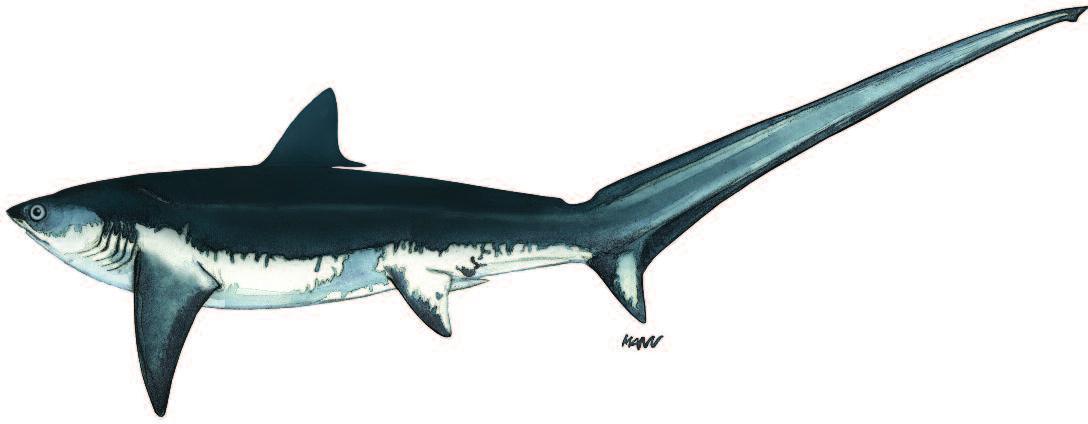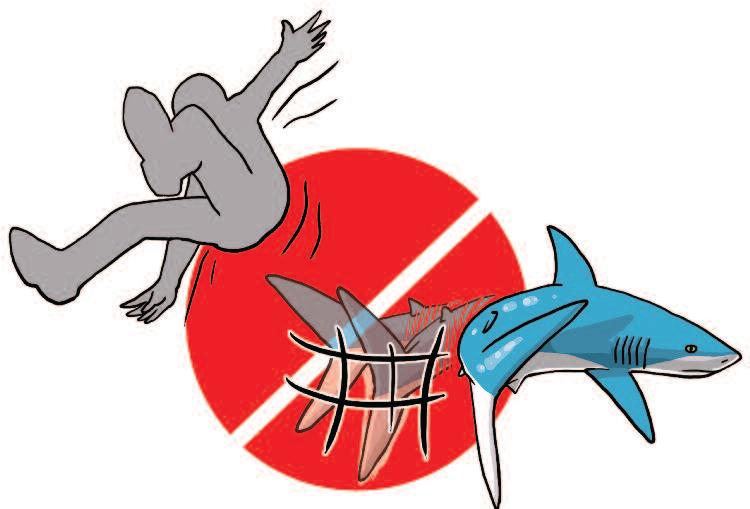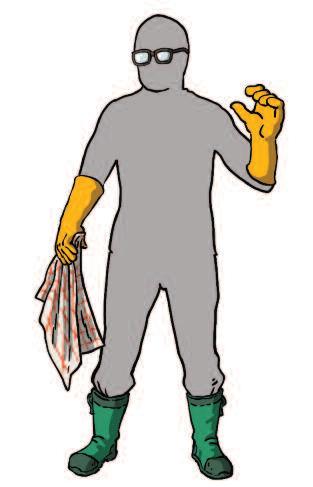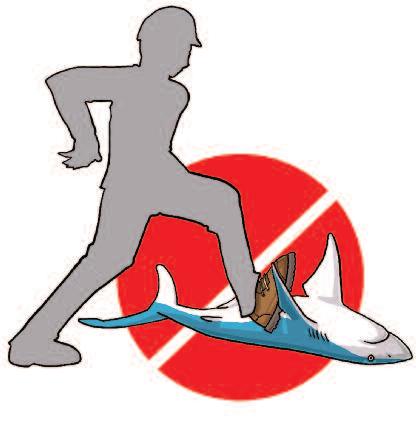

GOOD PRACTICE GUIDE FOR THE HANDLING OF SHARKS AND RAYS CAUGHT INCIDENTALLY IN MEDITERRANEAN PELAGIC LONGLINE FISHERIES
In collaboration with Financed by

BY MEDITERRANEAN PELAGIC LONGLINE FISHERIES (1/3)
1The illustrations are not drawn to scale


Porbeagle (Lamna nasus)
Corps massif et trapu.
Dorsal fin level with the pectoral fins
Peau ridée, surtout sur les 2/3 arrières du corps.
White patch at the rear of the dorsal fin
Pointed snout
Coloration grise-foncée à marron avec les contours de la gueule blancs et des tâches claires variables sur le ventre.
Shortfin mako shark (Isurus oxyrinchus)
Head longer than the pectoral fins
Wide mouth
Dorsal fin further back than the pectoral fins
Protected species, fishing is prohibited in the Mediterranean Sea. The reporting of any incidental catch is mandatory (see Technical Sheet 6)
Great white shark
MOST AFFECTED BY MEDITERRANEAN PELAGIC LONGLINE FISHERIES (2/3)
(Carcharodon carcharias)
Wide mouth
Long gill slits
Large dorsal fin
Long caudal keel

Conical snout
Common thresher
(Alopias vulpinus)
Small eyes
White belly
Dark brown and slate gray back becomi slate gray to dark blue on the flanks

Blue shark
(Prionace glauca)
Very slender body shape
Dark blue back and white belly
Long and pointed pectoral fins
Protected species, fishing is prohibited in the Mediterranean Sea. The reporting of any incidental catch is mandatory (see Technical Sheet 6)

Fishing of this species is allowed in the Mediterranean Sea, but the reporting of any catch is mandatory (see Technical Sheet 6)
AND RAY SPECIES MOST AFFECTED BY MEDITERRANEAN PELAGIC LONGLINE FISHERIES (3/3)

Bluntnose sixgill shark (Hexanchus griseus)
Small fluorescent green eyes
Six gill slits
Dorsal fin close to the tail
Pelagic stingray (Pteroplatytrygon violacea)
Rounded snout
Back without spines
Pelvic fins protruding from the disc
Bigeye thresher (Alopias superciliosus)
Deep frontal furrow
Purple gray back
Big eyes
White belly


PRECAUTIONS TO TAKE WHEN RELEASING SHARKS AND RAYS
CAUGHT IN PELAGIC LONGLINE FISHERIES
ALWAYS WATCH OUT FOR BITES, BLOWS AND STINGS!


HAVE THE CORRECT EQUIPMENT:

Hook remover
Pincers / Bolt cutters
Long-handled pruning shears
Gloves
Protective glasses



Removing the hook from the shark
If the shark is in the water
Cut the line as close as possible to the shark’s mouth
If the shark is on board
Cut the hook if possible or cut the line as close as possible to the hook ring
N.B. In order to release the shark as quickly as possible, it is best not to bring it on board.

Releasing the shark
Handle the shark holding a pectoral fin with one hand and the tail with the other.


Return the shark to the water, head first, without throwing it.
Let the animal slide.
Removing the hook from the ray
Rays rarely survive after release due to jaw damage. Although these animals are potentially dangerous, there are simple handling procedures that increase their chances of survival after release.
If the hook is lodged in the corner of the mouth

Cut the hook if possible or cut the line as close as possible to the hook ring.

If the ray is deep-hooked

Tie the end of line to a fixed point so as to have both hands free. Use a hook remover or a pair of pliers to grab hold of the tip of the hook and then rotate it in order to extract it. Cut the line to allow the ray to drop back into the water.
CAUGHT IN PELAGIC LONGLINE FISHERIES

Do not lift the shark by the tail or by the head


Do not carry the shark by its gill slits

Do not put your hands in the shark’s mouth to remove the hook
Do not carry the shark by inserting the boathook or other sharp objects into its body (jaws or gills)
Do not incise the flesh or cut the jaw of the ray to remove the hook




Do not cause any trauma that might damage the shark's internal organs (for example, do not put pieces of wood into its mouth or cut its flesh)
Do not expose the shark to the sun
FOR THE CATCH OF ANY SHARK SPECIES MARKED OR IN TECHNICAL SHEET 1, RECORD THE FOLLOWING INFORMATION IN THE LOGBOOK:


Date
GPS Position
Geographical subregion
Type of vessel (Fleet segment)
Fishing gear
Species caught
Total number of specimens caught
Number of specimens released alive
Number of dead specimens
Number of specimens in unknown status

And if possible…
Take photos of the shark(s)
The information above is extremely important! Please submit it, as soon as possible, to the relevant national authorities. If in doubt, ask for their help.
This guide was developed within the framework of a project which aimed to mitigate the negative i n t e r a c t i o n s b e t w e e n e n d a n g e re d m a r i n e s p e c i e s a n d f i s h i n g a c t i v i t i e s . T h i s p ro j e c t w a s i m plemented by the Secretariat of the Agreement on the Conservation of Cetaceans of the Black Sea, Mediterranean Sea and Contiguous Atlantic Area (ACCOBAMS) and by the Secretariat of the General Fisheries Commission for the Mediterranean (GFCM), in collaboration with the Specially Protected Areas Regional Activity Centre (SPA/RAC). The main objective of the project was to enhance the conservation of endangered marine species (cetaceans, sea turtles and seabirds, etc.) by promoting responsible fishing practices in the Mediterranean.
Technical and scientific contribution (in alphabetical order)
Aurora Nastasi, Julia Pierraccini, François Poisson Illustrations
Manuela D’Antoni, Organisation des Nations unies pour l’alimentation et l’agriculture, illustrations scientifiques originales reproduites avec permission (Fiche technique 1), François Dolambi (Fiches techniques 2-5), Alberto Gennari (Fiche technique 6)
Graphic design
Stile Libero Communication Monaco
Main bibliographic references
GFCM, 2012. Recommandation CGPM/36/2012/3 concernant des mesures de gestion des pêches pour la conservation des requins et des raies dans la zone d’application la CGPM.
GFCM, 2017. GFCM Data Collection Reference Framework (DCRF). Version: 2017.1
Poisson F., Wendling B., Cornella D. et Segorb C. 2015. Guide de bonnes pratiques pour réduire la mortalité des espèces sensibles capturées accidentellement par les palangriers français en Méditerranée. Projet SELPAL er RéPAST. 60 pages.
UNEP/MAP-SPA/RAC, 2018. Annex II to the Protocol concerning Specially Protected Areas and Biological Diversity in the Mediterranean: List of endangered or threatened species, SPA/RAC Ed., Tunis. http://www.rac-spa.org/sites/default/files/annex/annex 2 en 20182.pdf. Consulted on 29 March 2018
UNEP/MAP-SPA/RAC, 2012. Annex III to the Protocol concerning Specially Protected Areas and Biological Diversity in the Mediterranean: List of species whose exploitation is regulated, SPA/RAC Ed., Tunis. http://www.rac-spa.org/sites/default/files/annex/annex_3_en_2013.pdf. Consulted on 29 March 2018
The designations employed and the presentation of material in this information product do not imply the expression of any opinion whatsoever on the part of the Food and Agriculture Organization of the United Nations (FAO), or of the Secretariat of the Agreement on the Conser vation of Cetaceans of the Black Sea, Mediterranean Sea and contiguous Atlantic area (ACCOBAMS) concerning the legal or development status of any countr y, territor y, city or area or of its authorities, or concerning the delimitation of its frontiers or boundaries The mention of specific companies or products of manufacturers, whether or not these have been patented, does not imply that these have been endorsed or recommended by FAO, or ACCOBAMS in preference to others of a similar nature that are not mentioned The view s expressed in this information product are those of the author(s) and do not necessarily reflect the view s or policies of FAO, or ACCOBAMS
FAO and ACCOBAMS encourage the use, reproduction and dissemination of material in this information product. Except where other wise indicated, material may be copied, downloaded and printed for private study, research and teaching purposes, or for use in noncommercial products or ser vices, provided that appropriate acknowledgement of FAO and ACCOBAMS as the source and copyright holder is given and that FAO/ACCOBAMS’ endorsement of users ’ view s, products or ser vices is not implied in any way.
© FAO and ACCOBAMS, 2018
I9152EN/1/12 18
